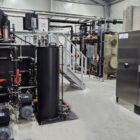The buffer capacity describes the ability of an aqueous system to withstand fluctuations in the pH value due to the addition of acids or bases. It is a key property in industrial water treatment and wastewater treatment, as many chemical and biological processes run optimally in narrow pH ranges. Insufficient buffering capacity can lead to unstable processes, material corrosion and inefficient use of chemicals.
Table of contents
Basics of buffer capacity
Definition of
The buffer capacity is the amount of strong acids or strong bases required to change the pH value of a system by one unit. It is often specified in mmol/L/pH or mg/L CaCO₃.
Chemical basis
The buffering capacity is based on the interaction between weak acids and their conjugate bases (or vice versa). The following chemical equilibria play a central role in water treatment processes:
Carbonic acid bicarbonate system:
- Main buffer system in natural and treated waters.
- Optimum buffer range: pH 6.3-10.3.
Phosphate system:
- Relevant in waste water and biological processes.
- Optimum buffer range: pH 2.1-12.3.
Ammonia-ammonium system:
- Important buffer in biological wastewater.
- Optimum buffer range: pH 8.3-9.3.
Importance of buffer capacity in water and wastewater technology
1. stabilization of processes
Many chemical and biological processes are pH-dependent:
Biological wastewater treatment:
- Microorganisms in activated sludge processes or anaerobic reactors require stable pH values (6.5-8.5) in order to work efficiently.
- Fluctuating buffer capacity can inhibit the activity of microorganisms.
Chemical precipitation and flocculation:
- Processes such as the precipitation of phosphate with iron or aluminum salts are strongly pH-dependent.
- A sufficient buffer capacity prevents pH deviations during the reaction.
2. avoidance of corrosion and deposits
- A low buffer capacity increases susceptibility to pH fluctuations, which can promote corrosion of pipes, tanks and pumps.
- Excessively high pH values promote the formation of limescale deposits (scaling), especially in systems with hard water.
3. optimization of the use of chemicals
- In recirculating water systems (e.g. cooling water circuits), a stable buffer capacity is crucial to avoid overdosing or inefficiency when adding biocides, inhibitors or pH regulators.
4. compliance with legal requirements
- Wastewater with unstable buffer capacity can have pH values outside the permissible limits (e.g. pH 6-9), which can lead to penalties or process interruptions.
Measurement of the buffer capacity
The buffer capacity is measured by titration:
- Direct acid/base titration:
- Add 0.1 N HCl (acid) or 0.1 N NaOH (base) to the sample.
- Determination of the amount of acid/base required to change the pH value by one unit.
- Alkalinity test:
- Measures the total concentration of bicarbonate, carbonate and hydroxide.
- Typically expressed in mg/L CaCO₃.
Optimization of buffer capacity in practice
1. use of chemicals
- Bicarbonates or carbonates:
- Add sodium hydrogen carbonate or calcium carbonate to increase the buffering capacity.
- Application: Stabilization of biological reactors.
- Phosphates:
- Addition of sodium phosphate to improve buffering in acidic areas.
- Hydroxides:
- Addition of sodium hydroxide solution for buffering in the alkaline range.
2. monitoring and control
- Automated pH control:
- Use of sensors and control systems for real-time monitoring of pH values.
- Regular alkalinity measurement:
- To determine the long-term stability of the system.
3. system design
- Recirculation of process water:
- Recycling of treated water with high alkalinity to increase the buffer capacity in the system.
- Buffer tank:
- Use of equalizing tanks to cushion strong pH fluctuations.
Conclusion
Buffer capacity is an essential parameter in water and wastewater treatment. It ensures the stability of chemical and biological processes, protects systems from corrosion and deposits and optimizes the use of chemicals. Through targeted measures such as the addition of buffering agents, automated pH control and regular alkalinity measurements, operators can ensure process stability and comply with legal requirements.
For further information on our products, please feel free to contact us at any time!








